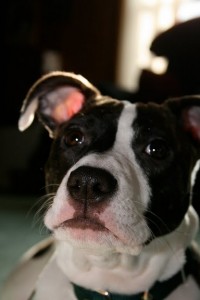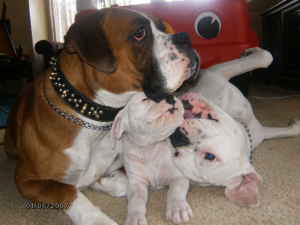If you and your veterinarian have decided to take surgical approach – TTA, TPLO, TTO, traditional/extracapsular/lateral suture repair, Tightrope – to correcting your dog’s cranial cruciate ligament rupture, you will want to be prepared for what to do prior to your dog’s knee surgery. The following checklist will provide a general idea of talking points to discuss with your canine’s vet prior to the ccl repair procedure. If you are aware of many of these policies and procedures before the surgery day, it will help to ease your worries about the surgery and ultimately make your dog’s recovery more relaxed.
List of Questions to Ask Your Vet Prior to Cranial Cruciate Ligament Surgery:
- Is your veterinarian board certified in surgery?
Many veterinarians perform surgeries, but this does not necessarily mean that they are board certified to do orthopedic procedures, such as cranial cruciate ligament repairs. Veterinarians performing tibial plateau leveling osteotomy procedures should also be additionally certified by the company that created the TPLO technique, as this is a more intense procedure than TTA or traditional repair. You can find a list of certified TPLO veterinarians here – Slocum Certified TPLO Vets
- How many of these types of procedures has your veterinarian performed? What is his overall success rate with this type of ccl repair surgery? Incidence of complications?
As mentioned above, veterinarians do not need to be specialized in orthopedic surgery to perform cranial cruciate ligament repairs, so one of the best ways to determine their experience and competence level is to look at the number of surgeries they have performed relative to their overall success rate vs. complications. Your veterinarian is required to be up-front with you regarding this information, and if you feel information is being withheld or your vet is uncomfortable discussing this topic, seek treatment elsewhere.
- Will my dog receive a complete physical examination prior to surgery?
Making sure your dog obtains a complete exam before surgery is your best defense from anesthetic death, cardiac arrest, allergic reactions and other complications.
- What safety precautions are taken during and immediately after surgery ?
While most surgery is uneventful, emergencies sometimes arise. Early detection of impending problems greatly aids our ability to intervene and correct the problem. A breathing tube should be placed on all anesthetized dogs, as that keeps the airway open and allows for supplemental oxygen or gas anesthesia as needed. A heart (EKG or ECG) and oxygen monitor allows the surgeon to keep track of heart rate and rhythm as well as the amount of oxygen in the blood.
Every veterinary practice should also have a “crash box” handy, which contains emergency drugs and supplies.Surgery patients lose body heat through anesthesia and the opening of body cavities and if patients get too cold, the heart can be affected. Patient temperature should be monitored at regular intervals after surgery and supplemental heating provided as needed. Your pet’s gum color, pulse, and respiration should also be monitored. You will also want to inquire as to whether the surgeon scrubs, caps, gowns, and gloves for every surgery and whether the surgeon uses a fresh, sterilized surgical pack for each patient. These steps are necessary in providing proper aseptic, sterile technique and instrumental in preventing post operative infection.
- How will my dog’s post operative pain be managed?
Anesthesia doesn’t control pain once the pet wakes up and pain medication should be offered. There are large, significant differences in anesthesia and pain control techniques among veterinarians. The type of pain relief used will depend on the size of the dog and procedure performed, but most pain is controlled successfully with the use of more than one medication in the immediate post operative period. The drugs and dosages should be chosen for that individual, instead of utilizing standard protocol used for every patient. You will also want to make sure that your clinic puts an intravenous catheter in every surgical patient and support the patient with intravenous fluids if necessary.
- How are the anesthetized patients monitored?
Ideally, there should be one person dedicated to monitoring each surgical patient, but this does not happen in every veterinary practice. At the very least you should make sure that your dog’s monitoring will be done by a certified veterinary technician or nurse, and that monitoring is done at regular intervals.
- How long will my dog have to stay after the CrCL procedure?
Again, this varies from clinic to clinic, but most veterinarians do prefer to keep the dog at least overnight for pain management reasons.
- Will my dog be receiving 24 hour a day care?
Most veterinary practices specializing in orthopedic surgery will have staff in the clinic 24-7, 365 days per year, as surgery is all they do. The same is not true for smaller veterinary practices and your dog may be alone for periods of time during his post op recovery. If your dog is to be left without supervision during the post op period make sure you find out how often someone is checking in at the office, and whether or not that person is the veterinarian. Also find out how your dog’s post operative pain will be managed in the absence of staff – whether an intravenous line will constantly supply an analgesic, or if oral medications alone will be used.
- What is an estimate of the cost for surgery? Does it include pre-op testing, post op visits and x-rays?
The last thing you want to do is be blown away at the cost of the procedure on the day of surgery. Most veterinary offices do not offer payment plans, and full payment for the entire balance of the surgery will be due on the day of the surgery. The price can range from $500-$3000 depending on which procedure your dog is having done and their size; larger dogs require more medication, anesthesia and general surgical supplies. Extra capsular or traditional repairs on smaller dogs will be at the bottom of this range, while TPLO’s on large dogs can cost upwards of $3000. It is important to find out exactly what costs are included in the estimate, as your dog will need post-op medications, office visits and radiography.
- Will I receive a handout with post-operative instructions?
Make sure you will be receiving written literature from your veterinarian’s office with instructions describing proper post-op care for your dog. Odds are you have been bombarded with information from all angles since your pet’s injury began, and it is helpful to have a guide for reference. The postop instructions should contain medication information and dosing information, normal behaviors to expect and signs of possible complications to which your vet should be informed.




Our 4 year old, 37lb. Shar-pei tore her ACL 3 weeks ago. The vet said it’s either a full tear or it’s hanging on by a thread. We were going to do conservative management, but decided to go ahead and get the “fishing line” surgery. We also didn’t want to dedicate months to conservative management, have it possibly fail, then dedicate more months to post-op rehab putting us into a winter (icy and slippery) recovery time. I did a lot of research on the web on conservative management, I like the idea of it and was ready to commit… then I inquired to a woman who sells raw meat dog food. She really recommended that we get the surgery because of the full tear. She said that she has been selling dog food for 9 years, and has seen many dogs in this situation (she is also a nurse at the local people hospital). I really listened to her advice and since she did not have any profit to be made off of us in this case (I wasn’t trusting of vets after reading so many bad things online), I listened. Our dog is young, athletic, and healthy and I am hoping I am making the right decision so she can have her normal life back again. Well- “normal” meaning that now she can not play with her best friend like a maniac anymore, which is how she injured herself in the first place.
How did everything work out as we are in the same situation currently……Thanks
I’m in same position with my 2 year old beagle. Need some guidance. Her vet did not have time to speak with me. Going to get a second opinion. I don’t want her to be on pain meds for long periods. She loves to play and run.
[…] Check out this website link for some specific questions to consider asking: DogKneeInjury.com: Questions to Ask Your Vet Prior to CCL Surgery […]